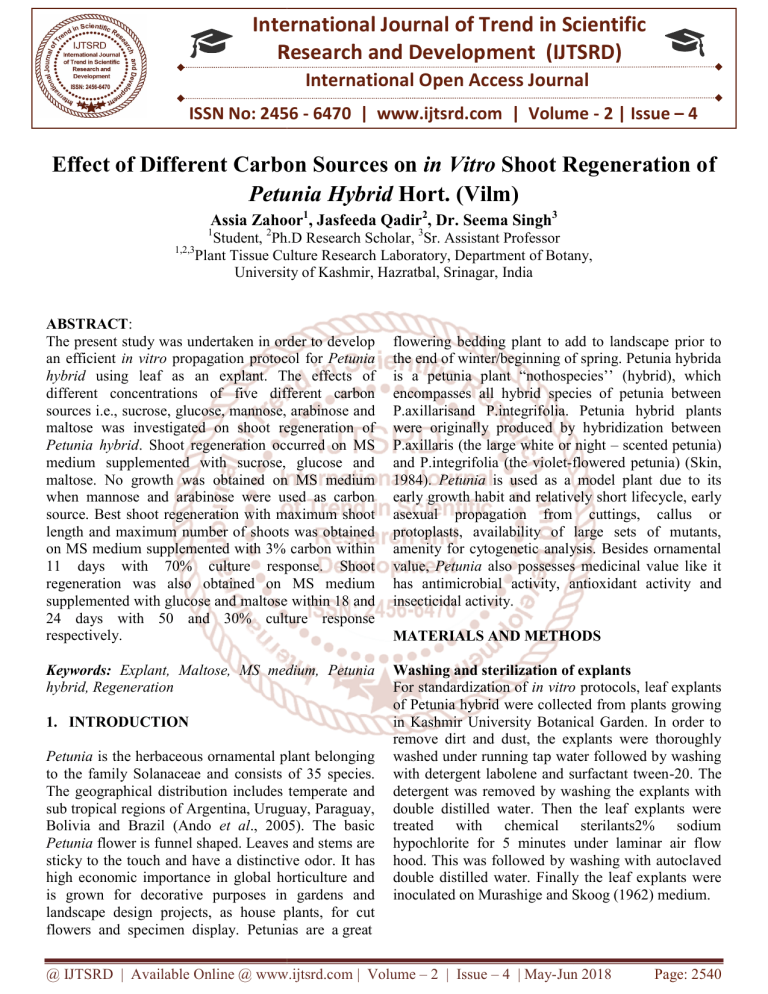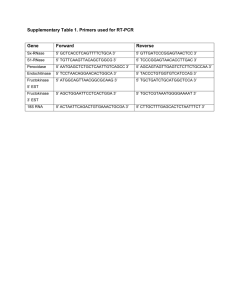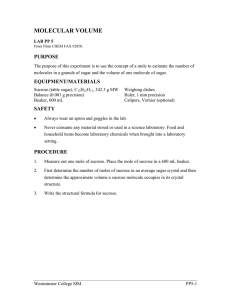
International Journal of Trend in Scientific
Research and Development (IJTSRD)
International Open Access Journal
ISSN No: 2456 - 6470 | www.ijtsrd.com | Volume - 2 | Issue – 4
Effect of Different Carbon Sources on in Vitro Shoot Regeneration of
o
Petunia Hybrid Hort. (Vilm)
Assia Zahoor1, Jasfeeda Qadir2, Dr. Seema Singh3
1
1,2,3
Student, 2Ph.D Research Scholar
Scholar, 3Sr. Assistant Professor
Plant Tissue Culture Research Laboratory, Department of Botany,
University of Kashmir, Hazratbal, Srinagar, India
ABSTRACT:
The present study was undertaken in order to develop
an efficient in vitro propagation protocol for Petunia
hybrid using leaf as an explant. The effects of
different concentrations of five different carbon
sources i.e., sucrose, glucose, mannose, arabinose and
maltose was investigated on shoot regeneration of
Petunia hybrid.. Shoot regeneration occurred on MS
medium supplemented with sucrose, glucose and
maltose. No growth was obtained on MS medium
when mannose and arabinose were used as carbon
source. Best shoot regeneration with maximum shoot
length and maximum number of shoots was obtained
on MS medium supplemented with 3% carbon within
11 days with 70% culture response. Shoot
regeneration was also obtained on MS medium
supplemented with glucose and maltosee within 18 and
24 days with 50 and 30% culture response
respectively.
Keywords: Explant, Maltose, MS medium, Petunia
hybrid, Regeneration
1. INTRODUCTION
Petunia is the herbaceous ornamental plant belonging
to the family Solanaceae and consists of 35 species.
The geographical distribution includes temperate and
sub tropical regions of Argentina, Uruguay, Paraguay,
Bolivia and Brazil (Ando et al.,., 2005). The basic
Petunia flower is funnel shaped. Leaves and stems are
sticky to the touch
uch and have a distinctive odor. It has
high economic importance in global horticulture and
is grown for decorative purposes in gardens and
landscape design projects, as house plants, for cut
flowers and specimen display. Petunias are a great
flowering bedding plant to add to landscape prior to
the end of winter/beginning of spring. Petunia hybrida
is a petunia plant “nothospecies’’ (hybrid), which
encompasses all hybrid species of petunia between
P.axillarisand P.integrifolia. Petunia hybrid plants
were originally produced by hybridization between
P.axillaris (the large white or night – scented petunia)
and P.integrifolia (the violet-flowered
flowered petunia) (Skin,
1984). Petunia is used as a model plant due to its
early growth habit and relatively short lifecycle, early
asexual propagation from cuttings, callus or
protoplasts, availability of large sets of mutants,
amenity for cytogenetic analysis. Besides ornamental
value, Petunia also possesses medicinal value like it
has antimicrobial activity, antioxidant activity and
insecticidal activity.
MATERIALS AND METHODS
Washing and sterilization of explants
For standardization of in vitro protocols, leaf explants
of Petunia hybrid were collected from plants growing
in Kashmir University Botanical Garden. In order to
remove dirt and dust, the explants were thoroughly
washed under running tap water followed by washing
with detergent labolene and surfactant tween-20.
tween
The
detergent was removed by washing the explants with
double distilled water. Then the leaf explants were
treated with chemical sterilants2% sodium
hypochlorite for 5 minutes under laminar air flow
hood. This was followed by washing with autoclaved
double distilled water. Finally the leaf explants were
inoculated on Murashige and Skoog (1962) medium.
@ IJTSRD | Available Online @ www.ijtsrd.com | Volume – 2 | Issue – 4 | May-Jun
Jun 2018
Page: 2540
International Journal of Trend in Scientific Research and Development (IJTSRD) ISSN: 2456-6470
Medium and culture conditions
Murashige and Skoog (1962) medium was gelled with
0.8% agar and supplemented with different
concentrations of different carbon sources (sucrose,
glucose, mannose, arabinose and maltose). The pH of
the medium was adjusted to 5.8 prior to autoclaving at
121 ºC and 15 lb pressure. The cultures were finally
incubated at 22±4 ºC and maintained under controlled
growth conditions.
RESULTS
In the present study, the effect of different carbon
sources (sucrose, glucose, mannose, arabinose and
maltose) on callus production and subsequent shoot
regeneration from leaf explant was investigated
(Table 1). MS medium supplemented with sucrose as
carbon source was found to be best where on
maximum number of callus was regenerated with
subsequent maximum number of shoot regeneration
within 11 days with 70 percent culture response (Fig.1
a). Callus and subsequent shooting was also observed
on MS medium supplemented withglucose and
maltose with 50 and 30 percent culture response
within 18 and 24 days respectively (Fig. 1b, 1c).
Keeping in view the results obtained from MS
medium fortified with sucrose, the effect of different
concentrations of sucrose i.e., 2%, 3% and 4% was
seen on shoot regeneration (Table 2).MS medium
supplemented with 3% sucrose was found to be best
medium where on maximum number of shoots were
regenerated in 70% cultures within 15 days (Fig.1d).
Shoot regeneration was also obtained when 2 and 4
percent sucrose was added to MS medium with
culture response of 30 and40% within 28 and 25 days
respectively (Fig. 1e, 1f).
a)
b)
c)
d)
e)
f)
Fig.1: In vitro shoot regeneration from leaf explant on MS medium fortified with
a) Sucrose b) Glucose c) Maltose
d) 3% sucrose e) 2% sucrose f) 4% sucrose
@ IJTSRD | Available Online @ www.ijtsrd.com | Volume – 2 | Issue – 4 | May-Jun 2018
Page: 2541
International Journal of Trend in Scientific Research and Development (IJTSRD) ISSN: 2456-6470
2456
Table 1: Effect of MS medium fortified with
different carbon sources on shoot regeneration of
Petunia hybrid:
No. of days
% Culture
response
Carbon
Callus
taken for
source
induction
shooting
Sucrose
+
11
70%
Glucose
+
18
50%
Maltose
+
24
30%
mannose
-
-
-
Arabinose -
-
-
germination of Petunia hybridaon
hybrida
MS medium
containing sucrose as a carbon source.
source Mahadevet al.
(2014) also studied the impact of different
carbohydrates and their concentrations on in vitro
regeneration of Solanumviarum (Dunal). He observed
that the maximum number of shoots and shoot length
was obtained on MS medium supplemented with 4%
fructose. Our results are in contrast with that of
Raquin(1983)who observed maltose as a carbon
source best for in vitro anther culture of petunia.
REFERENCES
1. Ando, T., Ishikawa, N., Watanabe, H., Kokubun,
H., Yanagisawa, Y., Hashimoto, G., Marches, E
and Suarez, E. A. (2005). Morphological study of
Petunia integrifoliacomplex
complex (Solnaceae). Annuals
of Botany. 96: 887-900
- No response; + Positive response
Table 2: Effect of MS medium fortified with
different concentrations of sucrose on shoot
regeneration of Petunia hybrid:
Carbon
Callus
No. Of days
%
source
inductio
taken for
Culture
n
shooting
response
2% Sucrose ++
18
30%
3% sucrose
+++
11
70%
4% sucrose
+
24
40%
+ low amount; ++ moderate amount; +++ high
amount
DISCUSSION
The aim of present study was to investigate the effect
of different carbon sources on the growth of Petunia
hybrida. The present study reveals that sucrose at 3%
concentration showed best results in terms of callus
induction and shoot regeneration. Similar results were
obtained by Marcelinaet al.. in 2015. He observed the
highest number of shoots in case of Petunia cv.’
Prism Rose’, on MS medium supplemented with
sucrose. Our results are also in accordance with that
of Yistraet al., who also found in vitro
vitropollen
2. Mahadev, N.D.M., Panathula, S.C., Naidu, V.C.
(2014). Impact of differentcarbohydrates and
their concentrations on in vitro regeneration of
Solanumviarum (Dunal)—
—Animportant anticancer
medicinal plant. American Journal of Plant
Sciences. 5:200-204.
3. Krupa-Małkiewicz,
Małkiewicz, M., Fornal, N., Kosatkal, A.
(2018). Effect of Carbohydrate source on in vitro
propagation and rooting of two cultivars of
Petunia (Petunia × Atkinsiana D. Don). Agric
Aliment PiscZootech.. 322:67-78.
322:
4. Raquin, C., (1893). Utilization of different sugars
as carbon source for in vitro anther culture of
Petunia. Zeitschrift Fur Pflanzenphysiologie.
111:453-457
5. Skin, K, C. (1984). Taxonomy.In: Sink KC, ed.
Petunia.New
New York: Springer, 3-9.
3
6. Yistra, B., Garrido, D., Jacqueline Busscher,
J., Tunen, J.A., (1998). Hexose Transport in
Growing Petunia Pollen Tubes and Characterization
of a Pollen-Specific,
Specific, Putative Monosaccharide
Transporter. DOI: https://doi.org/10.1104/.118https://doi.org/10.1104/
297.
@ IJTSRD | Available Online @ www.ijtsrd.com | Volume – 2 | Issue – 4 | May-Jun
Jun 2018
Page: 2542


